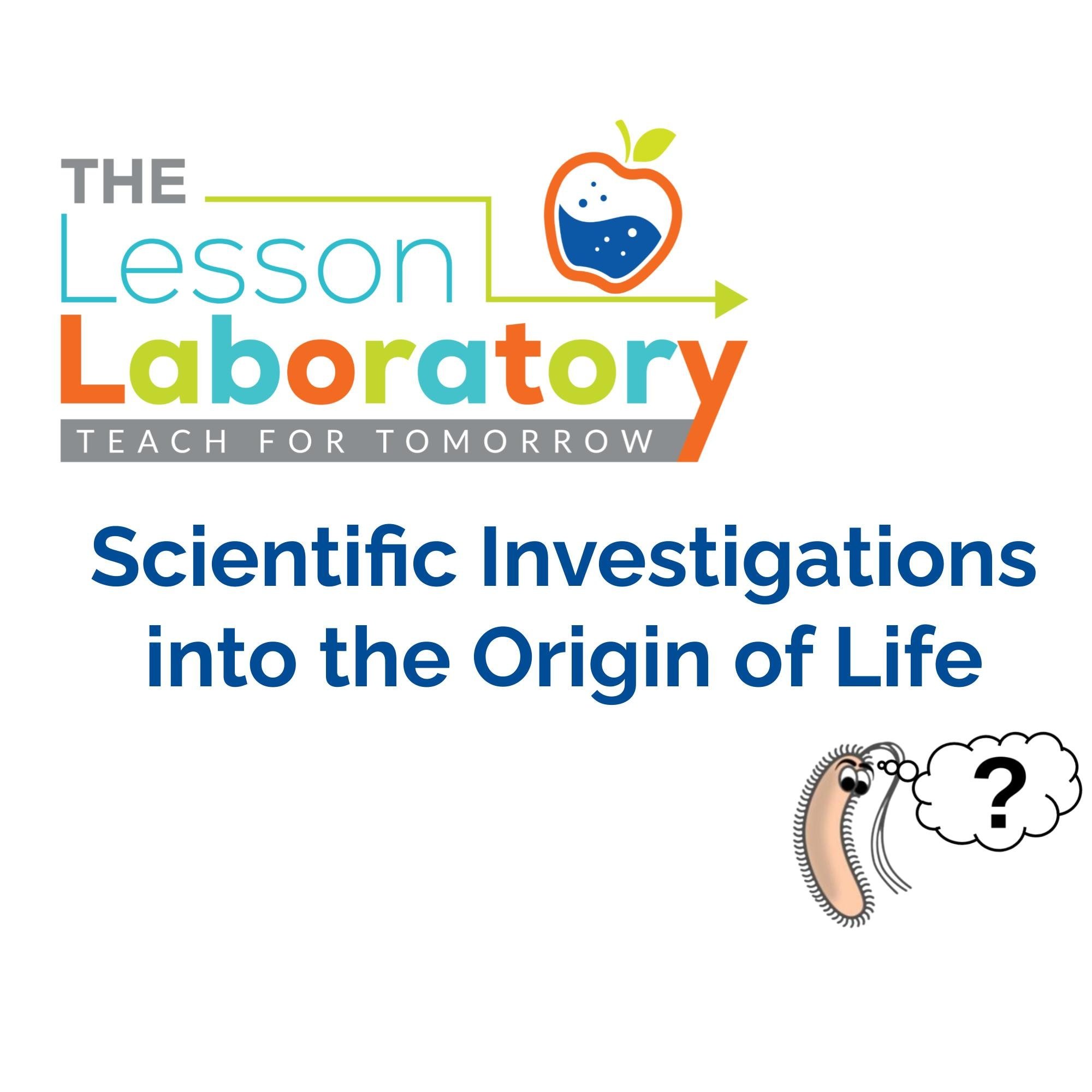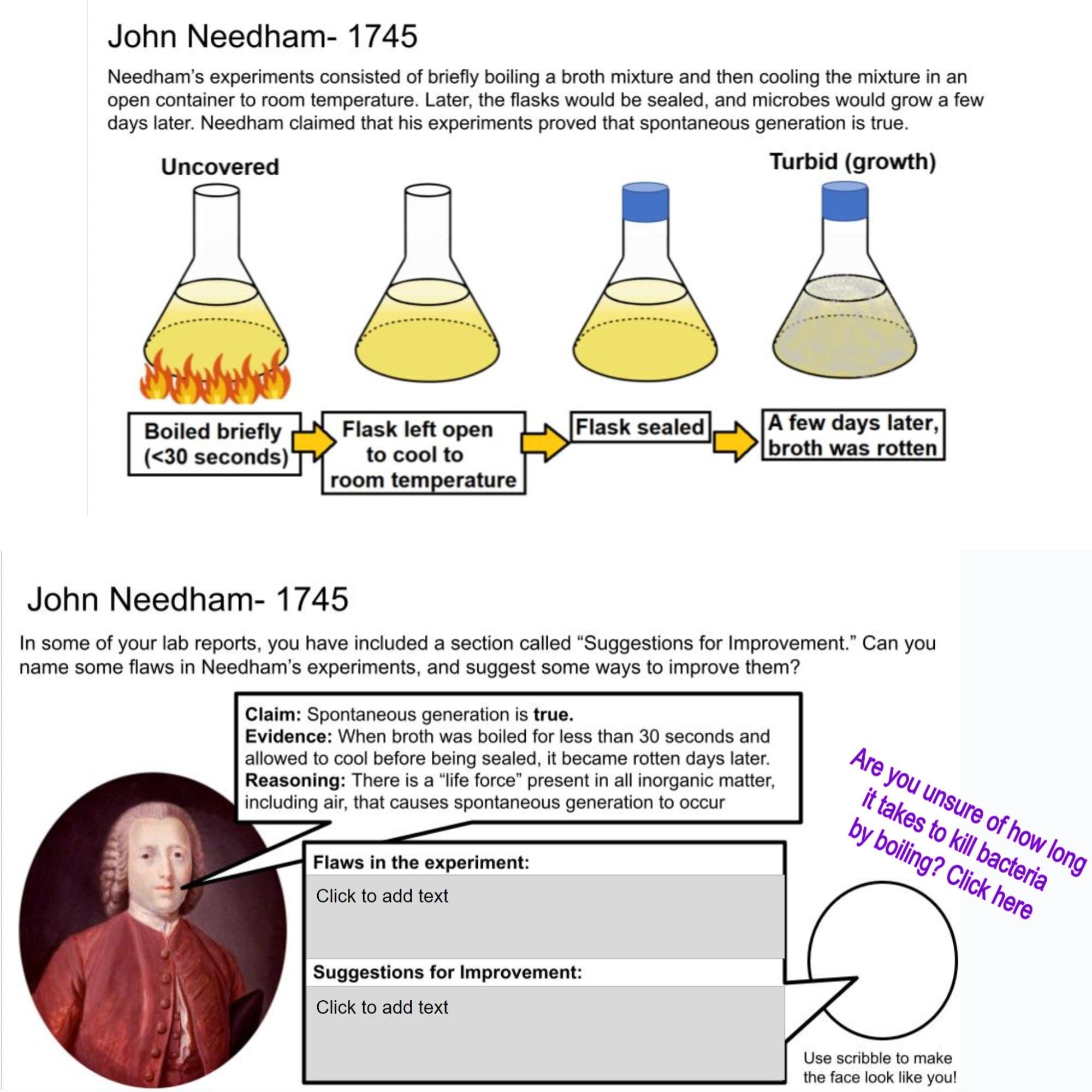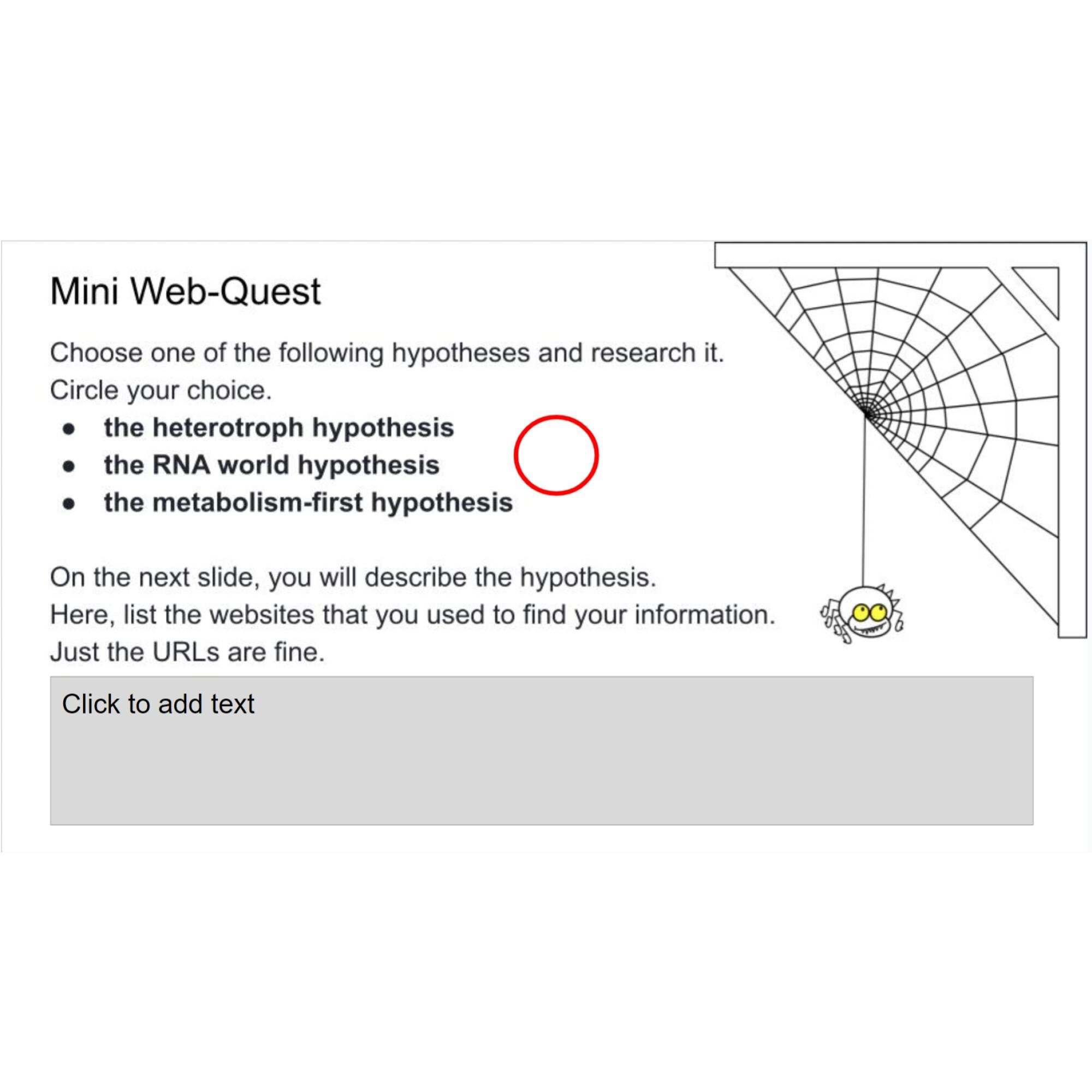 Image 1 of 4
Image 1 of 4

 Image 2 of 4
Image 2 of 4

 Image 3 of 4
Image 3 of 4

 Image 4 of 4
Image 4 of 4





Scientific Investigations into the Origin of Life
Embark on a Journey to Unravel the Origins of Life with this Captivating Google Slides Lesson!
Exploring the Mysteries of Existence: This beautifully designed interactive lesson leads students through a thought-provoking exploration of the origin of life. Each activity is crafted to engage and enlighten, guiding students towards a deeper understanding.
Student Activities:
Unveiling Spontaneous Generation: Students delve into the concept of spontaneous generation, unraveling how ancient thinkers would interpret various real-life scenarios. They then apply modern knowledge to explain these phenomena.
Redi's Experiment Exploration: Through interactive simulations, students simulate Francesco Redi's groundbreaking experiment. They strategically place maggots and flies to demonstrate the outcomes under different conditions, revealing the truth about spontaneous generation.
Critical Analysis of Needham's Experiments: Students scrutinize John Needham's experiments, identifying flaws and proposing improvements. This exercise sharpens their analytical thinking and scientific critique skills.
Pasteur's Defining Moment: Through engaging simulations, students replicate Louis Pasteur's pivotal experiment. They predict and observe the appearance of rotten broth under varying conditions, solidifying their understanding of spontaneous generation.
Tracing Life's Ancient Origins: Students delve into the staggering timeline of life on Earth, spanning over 3.5 billion years. This foundational knowledge sets the stage for deeper inquiries.
Probing Life's Genesis: Students tackle three fundamental questions: when did life emerge, where did it originate, and how did it begin? Each query invites them to ponder the enigmatic origins.
Chronicles of Life's Emergence: Through interactive timelines, students pinpoint their estimations of when life first emerged, offering a visual representation of their hypotheses.
Origins Unveiled: Students explore four potential origins of life. They then cast their votes for the most compelling hypothesis.
Unraveling the Mechanism: Students embark on a mini web-quest, delving into three riveting hypotheses for life's inception: the heterotroph hypothesis, the RNA world hypothesis, and the metabolism-first hypothesis.
Miller's Groundbreaking Experiment: Students analyze Stanley Miller's pioneering experiment, assessing its impact and significance in the quest to fathom life's beginnings.
Why Choose this Lesson?
Interactive Exploration: Engaging simulations and activities immerse students in the scientific journey of discovery.
Critical Thinking: Encourages analytical thinking and evaluation of historical experiments, fostering a deeper understanding of scientific methodology.
Connecting to Earth's History: Provides a context-rich exploration of life's ancient origins, connecting students to the profound story of existence.
Empowering Scientific Inquiry: Sparks curiosity and nurtures independent inquiry skills, essential for any budding scientist.
Embark on a Journey of Discovery: Download this captivating lesson now and watch students unravel the mysteries of life's origins!
To preview this product, highlight the link below and paste the address into your web browser.
https://docs.google.com/presentation/d/1qMkpCgBTK1W6Q_any4Yk0U_R17jpZ-8O3GrcZXJNDeA/edit?usp=sharing
Grade Recommendation
Grade Level: 9–12 (High School Biology or Honors Life Science)
This lesson examines historical and modern scientific explanations for the origin of life, from early spontaneous generation hypotheses to contemporary abiogenesis and RNA-world models. Students investigate the work of Redi, Pasteur, and Miller-Urey, using online sources and media clips to analyze how evidence shifted scientific consensus over time.
It’s best suited for:
Grade 9–10 Biology: Core unit on the cell theory and origin of life
Grade 11–12: As an enrichment or philosophical discussion lesson connecting biology and the nature of science
Cross-Curricular Connections
ELA Integration: Students engage in structured online research and evidence-based writing using digital resources.
Philosophy & History of Science: Examines how worldviews and scientific evidence have interacted historically.
Chemistry Integration: Ties into chemical bonding and organic molecule formation (Miller-Urey experiment).
Media Literacy: Involves evaluating reliability of scientific sources and interpreting visual media (videos, diagrams, web resources).
Extension Ideas:
Students could write a short essay comparing scientific reasoning vs. pseudoscience in early experiments.
Conduct a virtual simulation of the Miller-Urey experiment using a chemistry modeling app or website.
Daily slide + literacy - based exit ticket included with purchase
Join the Lesson Laboratory and Teach for Tomorrow!
NGSS (Next Generation Science Standards)
High School Life Science (HS-LS)
HS-LS1-6: Construct and revise an explanation based on evidence for how carbon, hydrogen, and oxygen from sugar molecules may combine with other elements to form amino acids and/or other large carbon-based molecules.
Connection: Students investigate how inorganic molecules could form organic compounds under early Earth conditions.HS-LS1-1: Construct an explanation based on evidence for how the structure of DNA determines the structure of proteins, which carry out life’s essential functions.
Connection: The lesson leads into this concept by exploring pre-cellular molecular organization.HS-LS3-1: Ask questions to clarify relationships about the role of DNA and chromosomes in coding traits passed from parents to offspring.
Connection: Students trace how self-replicating molecules (RNA, DNA) represent key steps in the transition from chemistry to biology.HS-LS4-1: Communicate scientific information that common ancestry and biological evolution are supported by multiple lines of empirical evidence.
Connection: Students examine experimental evidence (Miller-Urey, Pasteur) supporting naturalistic origins of life.
Science & Engineering Practices:
Analyzing and interpreting historical and modern scientific evidence
Constructing explanations and communicating results
Engaging in argument from evidence
Crosscutting Concepts:
Cause and Effect
Stability and Change
Patterns
Common Core Standards
Applicable Standards (Grades 9–12):
CCSS.ELA-LITERACY.RST.9-10.2: Determine central ideas and summarize scientific explanations (e.g., abiogenesis theories).
CCSS.ELA-LITERACY.RST.9-10.9: Compare and contrast findings from multiple sources and historical experiments.
CCSS.ELA-LITERACY.WHST.9-10.1: Write arguments focused on discipline-specific content, supporting claims with scientific reasoning.
CCSS.ELA-LITERACY.WHST.9-10.7: Conduct short research projects to answer a question or solve a problem.
CCSS.ELA-LITERACY.SL.9-10.1: Engage effectively in collaborative discussions to evaluate competing hypotheses.
Embark on a Journey to Unravel the Origins of Life with this Captivating Google Slides Lesson!
Exploring the Mysteries of Existence: This beautifully designed interactive lesson leads students through a thought-provoking exploration of the origin of life. Each activity is crafted to engage and enlighten, guiding students towards a deeper understanding.
Student Activities:
Unveiling Spontaneous Generation: Students delve into the concept of spontaneous generation, unraveling how ancient thinkers would interpret various real-life scenarios. They then apply modern knowledge to explain these phenomena.
Redi's Experiment Exploration: Through interactive simulations, students simulate Francesco Redi's groundbreaking experiment. They strategically place maggots and flies to demonstrate the outcomes under different conditions, revealing the truth about spontaneous generation.
Critical Analysis of Needham's Experiments: Students scrutinize John Needham's experiments, identifying flaws and proposing improvements. This exercise sharpens their analytical thinking and scientific critique skills.
Pasteur's Defining Moment: Through engaging simulations, students replicate Louis Pasteur's pivotal experiment. They predict and observe the appearance of rotten broth under varying conditions, solidifying their understanding of spontaneous generation.
Tracing Life's Ancient Origins: Students delve into the staggering timeline of life on Earth, spanning over 3.5 billion years. This foundational knowledge sets the stage for deeper inquiries.
Probing Life's Genesis: Students tackle three fundamental questions: when did life emerge, where did it originate, and how did it begin? Each query invites them to ponder the enigmatic origins.
Chronicles of Life's Emergence: Through interactive timelines, students pinpoint their estimations of when life first emerged, offering a visual representation of their hypotheses.
Origins Unveiled: Students explore four potential origins of life. They then cast their votes for the most compelling hypothesis.
Unraveling the Mechanism: Students embark on a mini web-quest, delving into three riveting hypotheses for life's inception: the heterotroph hypothesis, the RNA world hypothesis, and the metabolism-first hypothesis.
Miller's Groundbreaking Experiment: Students analyze Stanley Miller's pioneering experiment, assessing its impact and significance in the quest to fathom life's beginnings.
Why Choose this Lesson?
Interactive Exploration: Engaging simulations and activities immerse students in the scientific journey of discovery.
Critical Thinking: Encourages analytical thinking and evaluation of historical experiments, fostering a deeper understanding of scientific methodology.
Connecting to Earth's History: Provides a context-rich exploration of life's ancient origins, connecting students to the profound story of existence.
Empowering Scientific Inquiry: Sparks curiosity and nurtures independent inquiry skills, essential for any budding scientist.
Embark on a Journey of Discovery: Download this captivating lesson now and watch students unravel the mysteries of life's origins!
To preview this product, highlight the link below and paste the address into your web browser.
https://docs.google.com/presentation/d/1qMkpCgBTK1W6Q_any4Yk0U_R17jpZ-8O3GrcZXJNDeA/edit?usp=sharing
Grade Recommendation
Grade Level: 9–12 (High School Biology or Honors Life Science)
This lesson examines historical and modern scientific explanations for the origin of life, from early spontaneous generation hypotheses to contemporary abiogenesis and RNA-world models. Students investigate the work of Redi, Pasteur, and Miller-Urey, using online sources and media clips to analyze how evidence shifted scientific consensus over time.
It’s best suited for:
Grade 9–10 Biology: Core unit on the cell theory and origin of life
Grade 11–12: As an enrichment or philosophical discussion lesson connecting biology and the nature of science
Cross-Curricular Connections
ELA Integration: Students engage in structured online research and evidence-based writing using digital resources.
Philosophy & History of Science: Examines how worldviews and scientific evidence have interacted historically.
Chemistry Integration: Ties into chemical bonding and organic molecule formation (Miller-Urey experiment).
Media Literacy: Involves evaluating reliability of scientific sources and interpreting visual media (videos, diagrams, web resources).
Extension Ideas:
Students could write a short essay comparing scientific reasoning vs. pseudoscience in early experiments.
Conduct a virtual simulation of the Miller-Urey experiment using a chemistry modeling app or website.
Daily slide + literacy - based exit ticket included with purchase
Join the Lesson Laboratory and Teach for Tomorrow!
NGSS (Next Generation Science Standards)
High School Life Science (HS-LS)
HS-LS1-6: Construct and revise an explanation based on evidence for how carbon, hydrogen, and oxygen from sugar molecules may combine with other elements to form amino acids and/or other large carbon-based molecules.
Connection: Students investigate how inorganic molecules could form organic compounds under early Earth conditions.HS-LS1-1: Construct an explanation based on evidence for how the structure of DNA determines the structure of proteins, which carry out life’s essential functions.
Connection: The lesson leads into this concept by exploring pre-cellular molecular organization.HS-LS3-1: Ask questions to clarify relationships about the role of DNA and chromosomes in coding traits passed from parents to offspring.
Connection: Students trace how self-replicating molecules (RNA, DNA) represent key steps in the transition from chemistry to biology.HS-LS4-1: Communicate scientific information that common ancestry and biological evolution are supported by multiple lines of empirical evidence.
Connection: Students examine experimental evidence (Miller-Urey, Pasteur) supporting naturalistic origins of life.
Science & Engineering Practices:
Analyzing and interpreting historical and modern scientific evidence
Constructing explanations and communicating results
Engaging in argument from evidence
Crosscutting Concepts:
Cause and Effect
Stability and Change
Patterns
Common Core Standards
Applicable Standards (Grades 9–12):
CCSS.ELA-LITERACY.RST.9-10.2: Determine central ideas and summarize scientific explanations (e.g., abiogenesis theories).
CCSS.ELA-LITERACY.RST.9-10.9: Compare and contrast findings from multiple sources and historical experiments.
CCSS.ELA-LITERACY.WHST.9-10.1: Write arguments focused on discipline-specific content, supporting claims with scientific reasoning.
CCSS.ELA-LITERACY.WHST.9-10.7: Conduct short research projects to answer a question or solve a problem.
CCSS.ELA-LITERACY.SL.9-10.1: Engage effectively in collaborative discussions to evaluate competing hypotheses.